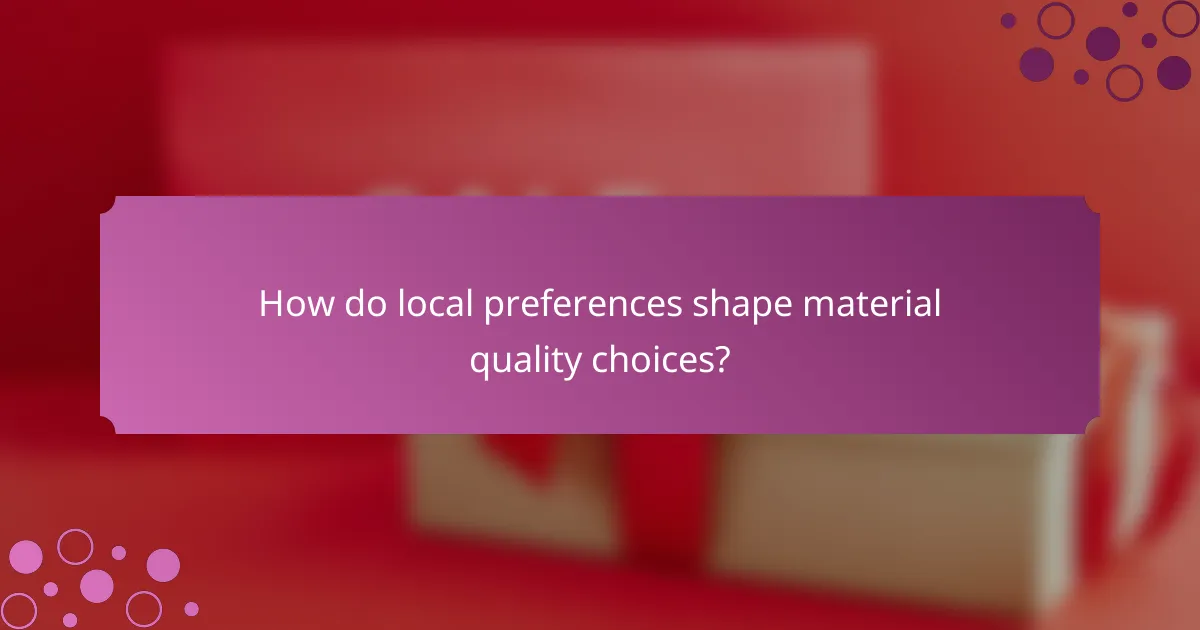The quality of materials used in products plays a crucial role in determining their value, longevity, and aesthetics. High-quality materials not only enhance the initial purchase price but also contribute to better durability and a more appealing visual presentation. As a result, investing in superior materials can lead to long-term benefits for consumers, both in terms of functionality and aesthetic satisfaction.

How does material quality affect value in Indian markets?
Material quality significantly impacts value in Indian markets by influencing both the initial purchase price and the potential resale value. High-quality materials often command higher prices due to their durability and aesthetic appeal, making them a wise investment for consumers.
High-quality materials increase resale value
Investing in high-quality materials can lead to a notable increase in resale value. For instance, furniture made from solid wood typically retains its worth better than particleboard alternatives. This is particularly relevant in markets like India, where traditional craftsmanship and material authenticity are highly valued.
When considering resale, items crafted from premium materials can often sell for 20-50% more than those made from lower-quality options. Buyers are generally willing to pay a premium for products that promise longevity and superior aesthetics.
Material certifications enhance perceived value
Certifications related to material quality can significantly enhance perceived value in the Indian market. For example, products certified as eco-friendly or made from sustainably sourced materials often attract environmentally conscious consumers, leading to higher sales prices.
Common certifications, such as ISO or FSSAI for food-related products, can also instill trust and credibility, making customers more likely to invest in higher-priced items. Always check for relevant certifications when assessing the value of materials, as they can serve as a strong selling point.

What is the impact of material quality on longevity?
Material quality significantly affects the longevity of a product, determining how well it withstands wear and tear over time. Higher quality materials typically offer better durability, leading to a longer lifespan and reduced need for replacement.
Durable materials extend product lifespan
Using durable materials can greatly enhance the lifespan of products. For instance, solid wood furniture often lasts decades, while particleboard may only last a few years. Investing in high-quality materials can save money in the long run by reducing the frequency of replacements.
Common durable materials include metals like stainless steel and high-density plastics, which are resistant to corrosion and impact. When choosing materials, consider their resistance to environmental factors such as moisture, UV light, and temperature fluctuations.
Maintenance requirements vary by material type
Different materials come with varying maintenance needs, which can impact their longevity. For example, natural wood requires regular sealing and polishing to prevent damage, while synthetic materials often need only occasional cleaning. Understanding these requirements can help you choose materials that fit your lifestyle.
When selecting materials, consider a balance between durability and maintenance. For instance, while ceramic tiles are durable and easy to clean, they may require careful handling to avoid chipping. Assess your willingness to maintain a product when evaluating material quality.

How does material quality influence aesthetics?
Material quality significantly impacts aesthetics by determining the visual appeal and overall impression of a product or space. High-quality materials often exhibit better textures, colors, and finishes, enhancing the attractiveness of the design.
Premium materials offer superior visual appeal
Using premium materials like hardwood, natural stone, or high-grade metals can elevate the visual appeal of any item. These materials typically have richer colors and textures, creating a more luxurious look. For instance, a solid oak table can convey warmth and sophistication compared to a laminate alternative.
Investing in quality materials can also improve the perceived value of a product. Consumers often associate higher prices with better materials, which can lead to increased demand and customer satisfaction.
Material finishes affect overall design quality
The finish applied to a material can dramatically alter its appearance and the overall quality of the design. For example, a matte finish may create a subtle, modern look, while a glossy finish can add vibrancy and depth. Choosing the right finish is essential for achieving the desired aesthetic effect.
Additionally, different finishes can enhance or diminish the durability of materials. A well-sealed wood finish can protect against moisture and wear, preserving the beauty of the material over time. When selecting finishes, consider both aesthetics and functionality to ensure long-lasting appeal.

What are the key factors in selecting quality materials?
When selecting quality materials, key factors include durability, aesthetic appeal, and sustainability. Understanding how these elements impact the overall value and longevity of a product is essential for making informed decisions.
Material sourcing and sustainability
Material sourcing refers to the process of obtaining raw materials, which can significantly affect the sustainability of a product. Choosing materials that are responsibly sourced, such as those certified by organizations like the Forest Stewardship Council (FSC), can enhance a product’s environmental profile.
Additionally, sustainable materials often have a lower carbon footprint and can contribute to a circular economy. For example, recycled metals and organic textiles not only reduce waste but also appeal to environmentally conscious consumers.
Cost vs. quality trade-offs
Balancing cost and quality is crucial when selecting materials. While higher-quality materials may come with a higher price tag, they often provide better durability and aesthetic appeal, leading to long-term savings. For instance, investing in solid wood furniture may be more expensive upfront but can last for decades compared to cheaper, less durable options.
When evaluating cost versus quality, consider the intended use and lifespan of the product. A good rule of thumb is to prioritize quality for items that will see heavy use, while lower-cost materials may suffice for decorative or less frequently used items.

How do local preferences shape material quality choices?
Local preferences significantly influence material quality choices by reflecting cultural values, environmental conditions, and economic factors. These preferences determine which materials are favored for their durability, aesthetic appeal, and suitability for specific climates.
Cultural influences on material selection
Cultural influences play a crucial role in material selection, as they dictate aesthetic preferences and functional requirements. For instance, in regions where traditional craftsmanship is valued, materials like wood or stone may be preferred for their authenticity and heritage.
Additionally, cultural significance can affect the perceived value of materials. In some cultures, certain materials may symbolize wealth or status, leading to a preference for luxurious options such as marble or high-quality metals.
Regional climate considerations
Regional climate significantly impacts material quality choices, as different environments require materials that can withstand specific weather conditions. For example, in humid climates, materials like treated wood or composite materials are often chosen for their resistance to moisture and decay.
Conversely, in arid regions, materials that can endure high temperatures and low humidity, such as brick or concrete, are preferred. Understanding these climate-related factors helps ensure the longevity and functionality of materials used in construction and design.

What emerging trends are influencing material quality in India?
In India, emerging trends such as the shift towards sustainable practices and advancements in technology are significantly impacting material quality. These trends not only enhance the longevity and aesthetics of products but also align with consumer preferences for eco-friendly options.
Rise of eco-friendly materials
The demand for eco-friendly materials in India is growing as consumers become more environmentally conscious. Materials like bamboo, recycled plastics, and organic textiles are gaining popularity due to their lower environmental impact and sustainability.
Using eco-friendly materials can improve product appeal and longevity, as they often possess unique properties that enhance durability. For instance, bamboo is not only renewable but also resistant to pests and moisture, making it a strong choice for various applications.
When selecting eco-friendly materials, consider certifications such as ISO 14001 for environmental management, which can help ensure that the materials meet sustainability standards.
Technological advancements in material science
Technological advancements in material science are revolutionizing the quality of materials used in various industries in India. Innovations such as nanotechnology and smart materials are enhancing performance characteristics, including strength, flexibility, and resistance to wear.
For example, the development of self-healing materials can significantly extend the lifespan of products by automatically repairing minor damages. This technology is particularly beneficial in sectors like construction and automotive, where durability is crucial.
To leverage these advancements, businesses should stay informed about the latest research and consider partnerships with material scientists or institutions to integrate cutting-edge materials into their products.


